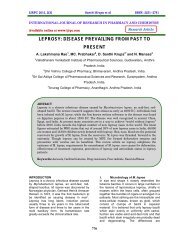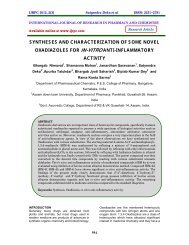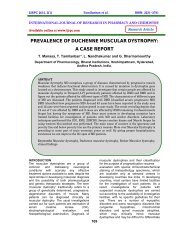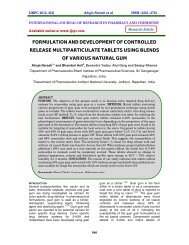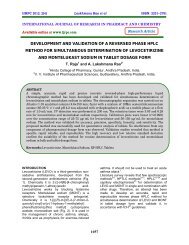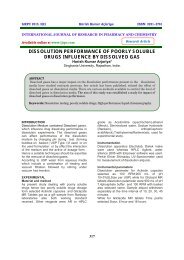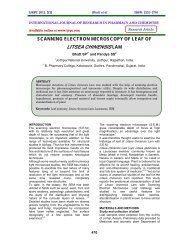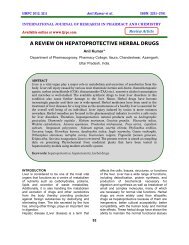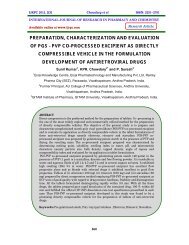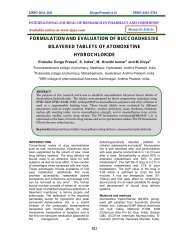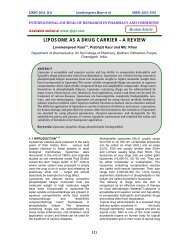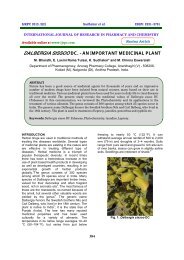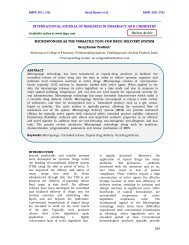NITRILE IMINES: VERSATILE INTERMEDIATES IN THE ... - ijrpc
NITRILE IMINES: VERSATILE INTERMEDIATES IN THE ... - ijrpc
NITRILE IMINES: VERSATILE INTERMEDIATES IN THE ... - ijrpc
Create successful ePaper yourself
Turn your PDF publications into a flip-book with our unique Google optimized e-Paper software.
IJRPC 2013, 3(1) Ajay Kumar et al ISSN: 22312781<br />
<strong>NITRILE</strong> <strong>IM<strong>IN</strong>ES</strong>: <strong>VERSATILE</strong> <strong><strong>IN</strong>TERMEDIATES</strong> <strong>IN</strong> <strong>THE</strong><br />
SYN<strong>THE</strong>SIS OF FIVE MEMBERED HETEROCYCLES<br />
K. Ajay Kumar 1 *, M. Govindaraju 2 and G. Vasanth Kumar 1<br />
1 Post Graduate Department of Chemistry, Yuvaraja’s College, University of Mysore,<br />
Mysore, Karnataka, India.<br />
2 Department of Chemistry, Sarada Vilas College, Mysore, Karnataka, India.<br />
ABSTRACT<br />
Nitrile imines are considered as the versatile reactive intermediates and are recognized as a<br />
linear-type 1,3-dipoles extensively used in 1,3-dipolar cycloaddition reactions for constructing<br />
biologically potent five membered heterocycles. This review article comprises the brief history,<br />
up to date information about the various methods employed for the generation, stability,<br />
reactivity and synthetic applications of nitrile imines. The stereochemistry of the products formed<br />
with the use of nitrile imines and biological activity associated with the cycloadducts formed was<br />
also presented.<br />
Keywords: Pyrolysis, photolysis, cycloaddition, pyrazoles, tetrazoles.<br />
<strong>IN</strong>TRODUCTION<br />
The concept of 1,3-dipolar cycloaddition<br />
was developed in the early 1950s<br />
Huisgen and co-workers; which has led<br />
to one of the most versatile methods for<br />
the construction of five-membered ring<br />
heterocycles. Most nitrile imines are<br />
highly reactive and in the absence of<br />
trapping agents they undergo rapid<br />
dipolar cycloaddition with themselves.<br />
Although first known only as transient<br />
intermediates, nitrile imines have been at<br />
the heart of mechanistic studies of 1,3-<br />
dipolar cycloaddition reactions.<br />
Although hundreds of mechanistic<br />
papers on nitrile imines were appeared in<br />
1970s; reliable spectroscopic<br />
observations were achieved in the early<br />
1980s both at low temperatures and in<br />
the gas phase; the first crystalline nitrile<br />
imine was reported in 1988. The unusual<br />
structures found by X-ray analyses as<br />
well as the facile rearrangements<br />
observed experimentally have fostered a<br />
new interplay between experiment and<br />
theory. The story of nitrile imines, from<br />
matrix characterization to stable<br />
compounds, nicely illustrates the role<br />
that main group elements can play in<br />
organic chemistry 1 . Hans Bock et al 2<br />
reported the photoelectron spectra of<br />
nitrile imines obtained by flash vaccum<br />
pyrolysis of tetrazoles; their study<br />
accounts the geometry and electronic<br />
structure of nitrile imines.<br />
An isomer of diazomethane, the nitrile<br />
imine, HC≡N=NH is reported to be a<br />
stable molecule in the gas phase. Upon<br />
neutralizing the α-distonic<br />
HCNNH + cation in a beam experiment,<br />
this long-time predicted ylide can be<br />
generated. The experiments are<br />
supported by theoretical calculations<br />
(DFT/HF hybride method) on the neutral<br />
and cationic diazomethane, nitrile imine,<br />
and N-isocyano amine as well as the<br />
transition states for their<br />
interconversion 3 .<br />
Four alternative structures have been<br />
postulated for the non-stabilized nitrile<br />
imines: propargylic (1a), allenic (1b), 1,3-<br />
dipolar (1c), and carbonic (1d) structure.<br />
140
IJRPC 2013, 3(1) Ajay Kumar et al ISSN: 22312781<br />
These structures were depicted in<br />
(Scheme-1).<br />
GENERATION OF <strong>NITRILE</strong> <strong>IM<strong>IN</strong>ES</strong><br />
The usual synthesis of nitrile imines (3)<br />
involves the thermolysis or photolysis of<br />
tetrazole (2) 5-6 , flash vaccum pyrolysis of<br />
tetrazoles 2 (Scheme-2).<br />
The literature reveals that the theoretic<br />
calculations of the nitrile imine structures<br />
have generated the conflicting results.<br />
For instance, a high-level calculation<br />
study with the configuration interaction<br />
(QCISD) and a large basis-set concluded<br />
that the stable nitrile imine structure has<br />
a non-planar, allenic geometry and that<br />
the propargylic structure does not<br />
correspond to a local minimum on the<br />
potential energy surface. DFT<br />
calculations in combination with the<br />
natural resonance theory indicated that<br />
all four resonance structures are<br />
necessary for a full description and that<br />
the carbenic form dominates for F-CNN-<br />
F and H 2 N-CNN-NH 2 . In contrast, a spincoupled<br />
valence bond calculation using<br />
the geometry from a CASSCF calculation<br />
suggested that the stable electronic<br />
structure of H-CNN-H is predominantly<br />
propargylic. To overcome this; Zheng et<br />
al 4 conducted photocrystallography<br />
experiments and reported the direct<br />
observation of a bent geometry for a<br />
nonstabilized nitrile imine in a metalcoordination<br />
crystal. The photoinduced<br />
tetrazole ring rupture to release N 2<br />
appears to depend on the size of voids<br />
around the N(3)-N(4) bond in the crystal<br />
lattice. Accoridng to their studies, the<br />
bent nitrile imine geometry agrees with<br />
the 1,3-dipolar structure, a transient<br />
reactive species that mediates the<br />
photoinduced 1,3-dipolar cycloaddition in<br />
the aqueous medium.<br />
Catalytic oxidation of aldehyde<br />
hydrazones (4) with lead tetraacetate 7 ,<br />
Chloramine-T 8 , mercuric acetate 9 , leads<br />
to the formation of nitrile imines (5)<br />
(Scheme-3); which can be trapped in situ<br />
by various dipolaphiles to produces five<br />
membered heterocycles such as<br />
pyrazolines, pyrazoles, triazoles,<br />
tetrazoles etc.<br />
Dehydrohalogenation of hydrazonoyl<br />
chlorides (6) by treating with a base<br />
triethylamine 5 , or with silver carbonate in<br />
dioxane 10 also leads to the generation of<br />
nitrile imines (5) (Scheme-4). There were<br />
reports that nitrile imines are also<br />
generated by the photolysis of<br />
sydnones 11 .<br />
The spectral and kinetic behavior of<br />
nitrile imines photogenerated from<br />
sydnones and tetrazoles in fluid solutions<br />
has been studied by laser and lamp flash<br />
photolysis. The nitrile imines are<br />
characterized by lifetimes of milliseconds<br />
and are quenchable by the dipolarophile<br />
dimethyl acetylenedicarboxylate and by<br />
carboxylic acids. The<br />
141
IJRPC 2013, 3(1) Ajay Kumar et al ISSN: 22312781<br />
phototransformation of 3,4-diarylsydnones<br />
to the corresponding N,Cdiarylnitrile<br />
imines occurs rapidly; this<br />
suggests that bicyclic diaziridine,<br />
diazirine or 1,2,3-oxadiazolin-5-one<br />
intermediates, postulated in the literature<br />
as precursors for nitrile imines, are either<br />
very short lived or not involved at all. The<br />
laser flash photolysis of the sydnones<br />
unsubstituted at the 4-position or bearing<br />
a methyl group at this position gives rise<br />
to additional, fast-decaying, transient<br />
species which become progressively<br />
longer lived upon interaction with<br />
hydroxylic reagents. Possible<br />
assignments of these transient species in<br />
terms of ylide structures are discussed in<br />
the light of the results of steady state<br />
photolysis at low temperatures 11 .<br />
APPLICATIONS OF <strong>NITRILE</strong> <strong>IM<strong>IN</strong>ES</strong><br />
Rai and co-workers 8 reported a new<br />
approach for the synthesis of pyrazoles<br />
via 1,3-diplar cycloaddition of acetyl<br />
acetone and in situ generated nitrile<br />
imines by the catalytic dehydrogenation<br />
of phenylhydrazones using chloramine-T<br />
as oxidant. The reaction afforded the<br />
regioselective cycloadducts in good<br />
yield. They developed and first reported<br />
the in situ generation of nitrile imines by<br />
the reaction of aldehyde hydrazones with<br />
mercuric acetate 9 . They carried out the<br />
reaction of aldehyde hydrazones with<br />
mercuric acetate in the presence of<br />
olefins and obtained the 1,3,5-<br />
trisubstituted 2-pyrazolines in good yield.<br />
The reaction of homochiral hydrazonoyl<br />
chlorides (6) with silver carbonate in<br />
dioxane produced corresponding<br />
nitrile imne; which undergo<br />
intramolecular cycloaddition in the<br />
absence of trapping agents to give<br />
diastereoisomeric mixture of 3,3a-<br />
dihydro-pyrazolo[1,5-<br />
a][1,4]benzodiazepine-6(4H)-ones (7)<br />
and (8) in enantiopure form (Scheme-<br />
5) 10 .<br />
The nitrile imines (9) undergo<br />
rearrangement reaction between -78 and<br />
+55°C, the rearrangement temperature<br />
depending on the substituents to<br />
produce rearranged products (10). The<br />
nitrile imines can be characterized in<br />
solution by NMR and IR spectroscopy.<br />
Compounds (9), E = SiMe 3 and SiPh 3 ,<br />
have also been trapped with methanol<br />
and with methyl acrylate (Scheme-6) 12 .<br />
Compound (11), which first melts above<br />
300°C without decomposition, is formed<br />
via nitrile imine–imidoylnitrene<br />
rearrangement upon reaction of the<br />
nitrile imine (12) with tetrachloro-obenzoquinone.<br />
The surprising thermal<br />
stability of (11) could be due to the<br />
coordination of an oxygen atom to the<br />
nitrene nitrogen atom (R = NiPr 2 ) 13 .<br />
142
IJRPC 2013, 3(1) Ajay Kumar et al ISSN: 22312781<br />
N-Aryl-C-ethoxycarbonylnitrile imines<br />
react with meso-tetrakis<br />
(pentafluorophenyl) porphyrin in 1,3-<br />
dipolar cycloadditions to yield novel<br />
pyrazolochlorins in moderate yields. The<br />
nitrile imines were generated in situ by<br />
base-induced dehydrobromination of<br />
ethyl hydrazono-α-bromoglyoxylates. A<br />
number of different experimental<br />
conditions were considered for these<br />
cycloadditions, namely different bases,<br />
solvents and temperature; the best<br />
results were obtained using potassium<br />
carbonate in refluxing toluene. The<br />
photophysical properties of the new<br />
chlorins were investigated and the<br />
results suggest that two of them have<br />
potential for use in photodynamic<br />
therapy 14 .<br />
Nitrilimines are found to be useful<br />
reactive intermediates in azaheterocyclic<br />
synthesis; They undergo two main<br />
cyclization reactions: 1,3-dipolar<br />
cycloaddition reactions with multiple<br />
bonds and cyclocondensation reactions<br />
with nucleophilic substrates containing<br />
suitably located electrophilic centers<br />
leading to various heterocyclic<br />
compounds. For instance; C-Aroyl-Narylnitrilimines<br />
(14) generated by the<br />
reaction of hydrazonoyl halides (13) with<br />
triethylamine in tetrahydrofuran was<br />
trapped in situ by alkanal<br />
methylhydrazones (15) to afford 1,3,4,6-<br />
tetrasubstituted 1,2,4,5-tetrazines (16) in<br />
good yield (Scheme-7) 15 .<br />
Nitrile imine generated in situ from N-<br />
arylhydrazonoyl chloride precursor reacts<br />
with methyl ester of α-amino carboxylic<br />
acid (17) to give condensed product;<br />
which undergo cyclisation under reaction<br />
conditions to form substituted triazine<br />
analogs (18). On the otherhands, it adds<br />
onto -Aminobutyric acid (GABA) to<br />
deliver the corresponding acyclic<br />
amidrazone adducts (19); which in the<br />
presence of 1,1’-carbonyldiimidazole<br />
undergo cyclocondensation involving the<br />
activated carboxyl and the amidrazone -<br />
CH 2 NH groups to afford the respective<br />
N-[1-(arylhydrazono)-2-oxopropan-1-<br />
yl]pyrrolidin-2-ones (20) (Scheme-8) 16 .<br />
1,3-Dipolar cycloaddition between<br />
aromatic selenoaldehydes and aromatic<br />
N-phenyl nitrile imines generated in situ<br />
by the dehydrochlorination of<br />
hydrazonoyl chlorides (21) with<br />
triethylamine proceeded efficiently to<br />
give the corresponding [3+2]<br />
143
IJRPC 2013, 3(1) Ajay Kumar et al ISSN: 22312781<br />
cycloadducts as a single isomer 1,3,4-<br />
selenadiazoles (22) in good yields<br />
(Scheme-9) 17 . The study reports that<br />
these selenium containing fivemembered<br />
heterocycles were stable at<br />
room temperature in the atmosphere.<br />
Alternatively they may be chemically<br />
modified on the resin prior to elimination<br />
from the polymer. The cycloadditionelimination<br />
sequence is regiospecific for<br />
the 3,4-disubstituted pyrazole isomer and<br />
the products are obtained in good to high<br />
yield and in high purity 19 . Huisgen<br />
reaction of nitrile imines generated in situ<br />
in the presence of N-benzylmaleimide<br />
afforded regiospecifically the<br />
corresponding cycloadducts (25) 20 in<br />
good yield.<br />
The reaction of nitrile imines generated<br />
in situ by the dehydrochlorination of C-(2-<br />
furoyl)-, C-(2-thenoyl)- and C-<br />
(phenylaminocarbonyl) hydrazonoyl<br />
chlorides with triethylamine with<br />
cycloalkanone oximes (23) give<br />
unexpected 3-substituted 1-aryl-1,2,4-<br />
triazaspiroalk-2-enes (24) (Scheme-<br />
10) 18 . Although initially, the reaction was<br />
expected to produce cycloaddition<br />
products 1,2,4-triazoles or<br />
cyclocondensation products 1,2,4,5-<br />
oxatriazines, it produced (24); the<br />
formation of compounds (24) is assumed<br />
to involve cycloaddition adducts 1,2,4-<br />
triazoles which tautomerize to amine<br />
oxide-type intermediates that are<br />
deoxygenated by triethylamine.<br />
The 1,3-dipolar cycloaddition reaction<br />
between nitrile imines and resin-bound<br />
enamines gives resin-bound pyrazoline<br />
intermediates. The piperazine resin<br />
functions as a traceless linker and allows<br />
these intermediates to be cleaved<br />
directly from the resin under mild acid<br />
conditions to afford 1,4-diarylpyrazoles.<br />
The 1,3-cycloaddition of the nitrile<br />
imines to the carbon-carbon double<br />
bond in benzalacetophenone leads to the<br />
formation of 4-phenyl-5-<br />
benzoylpyrazolines; which were<br />
converted into 4-phenyl-5-<br />
benzoylpyrazoles upon treatment with<br />
chloranil in xylene. However, the<br />
cycloaddition of nitrile imines to the<br />
carbon-carbon double bond in the enol<br />
tautomer of dibenzoylmethane gives the<br />
regioisomers 5-phenyl-5-hydroxy-4-<br />
benzoylpyrazolines which loose<br />
elements of water to yield 4-benzoyl-5-<br />
phenylpyrazoles 21 . Reaction of 5-<br />
substituted-2-methyl-3(2H)-<br />
pyridazinones with diarylnitrile imines<br />
generated in situ with chloramine-T has<br />
been shown to afford diarylpyrazolo[3,4-<br />
d]pyridazin-4(5H)-ones (Scheme-11) 22 .<br />
Reactivity and regiochemistry were<br />
analyzed by FMO theory.<br />
144
IJRPC 2013, 3(1) Ajay Kumar et al ISSN: 22312781<br />
Reactions of nitrile imines with 2-<br />
methoxyvinyl phenyl ketone are less<br />
regioselective yielding both 4-<br />
benzoylpyrazoles and 5-<br />
benzoytpyrazoles, whereas no biscycloadducts<br />
were isolated 23 . A synthetic<br />
route to the pyrazolo[1,5-<br />
a][1,4]benzodiazepines (26) system is<br />
described, which starts from isatoic<br />
anhydride and allylamines, and involves<br />
as the key step an intramolecular nitrile<br />
imine cycloaddition. The title ring system<br />
has been prepared through a synthetic<br />
sequence involving a intramolecular<br />
nitrile imine cycloaddition as the key<br />
step 24 .<br />
1,3-Dipolar cycloaddition of nitrile imines<br />
with α,β-unsaturated five- and sixmembered<br />
lactones, thiolactones and<br />
lactams gave ring-fused pyrazoles.<br />
Regioisomeric mixtures have been<br />
obtained with the 5-substituted pyrazole<br />
as the major cycloadducts (Scheme-13).<br />
Only with the five-membered lactone the<br />
major product was the 4-acyl derivative.<br />
Computational studies, the use of the<br />
topological analysis of the Fukui<br />
functions and the potential energy<br />
surfaces (PES) theory allowed a<br />
theoretical description of the local<br />
reactivity in agreement with the observed<br />
high regiochemistry and with the role of<br />
the heteroatom adjacent to the carbonyl<br />
group 26 .<br />
3-Mercaptopropionic acid-nitrile imine<br />
acyclic adducts (27) undergo<br />
cyclocondensation with 1,1′-<br />
carbonyldiimidazole to afford the<br />
respective 1,3,4-thiadiazol-2-(3H)-ones<br />
or 1,3,4-thiadiazol-2(3H)-thiones (28)<br />
with consequent elimination of the<br />
propionate moiety (Scheme-12) 25 . The<br />
constitution of these heterocyclic<br />
products follows from analytical and<br />
spectral data and is confirmed by single<br />
crystal X-ray structure determination.<br />
Extremely fast fluorescence labeling (
IJRPC 2013, 3(1) Ajay Kumar et al ISSN: 22312781<br />
pyridazin-3(2H)-ones 28 have been<br />
synthesized as useful synthetic<br />
intermediates; they allow formation of a<br />
new hydrazides, hydrazidoyl chlorides<br />
and the highly reactive nitrile imine<br />
species. Dimerization and reaction of the<br />
latter species with benzonitrile,<br />
benzaldehyde and their p-methoxy and<br />
p-nitro derivatives provides a convenient<br />
method for the synthesis of substituted<br />
1,2,4,5-tetrazines, 1,2,4-triazoles and<br />
1,3,4-oxadiazoles respectively, with<br />
pyridazin-3(2H)-one moiety.<br />
Huisgen reaction of nitrile imines<br />
generated in situ in the presence of N-<br />
benzylmaleimide afforded regionspecifically<br />
the cis-3-aryl-5-benzyl-1-<br />
(2',4'-dibromophenyl)-3a, 4,6,6a-<br />
tetrahydro-1H,5H-pyrrolo[3,4-c]pyrazole-<br />
4,6-diones in good yield 29 . Nitrile imines<br />
react with 1-phenylsulphonyl-2-benzoyl<br />
(or methoxycarbonyl)alkenes to give 4-<br />
phenylsulphonyl-5-benzoyl<br />
(or<br />
methoxycarbonyl)<br />
substituted<br />
pyrazolines 30 . The cycloaddition<br />
regioselectivity is discussed in terms of<br />
Frontier Orbital energies and coefficients.<br />
Recently Ajay Kumar and co-workers 31<br />
reported the use of in situ generated<br />
nitrile imines in the synthesis of 1,3,5-<br />
triaryl-4,6-dioxo-pyrrolo[3,4-d]-7,8-<br />
dihydropyrazoles. They carried out a<br />
reaction of a mixture of N-aryl maleimide,<br />
aldehyde hydrazone and chloramine-T in<br />
ethyl alcohol and obtained the<br />
cycloadducts in moderate to good yield<br />
(Scheme-14). The synthesized 1,3,5-<br />
triaryl-4,6-dioxo-pyrrolo[3,4-d]-7,8-<br />
dihydropyrazoles have been evaluated in<br />
vitro for their antibacterial, antifungal and<br />
antioxidant activities. The results of the<br />
study indicated that some of the<br />
compounds posses promising activity 32 .<br />
Aldehyde phenyl hydrazones undergo<br />
oxidative dehydrogenation with<br />
Chloramine-T to give nitrile imines, which<br />
are trapped in situ by ethyl oleate to<br />
afford 8-(5-Aryl-4-octyl-2-phenyl-3,4-<br />
dihydro-2H-pyrazol-3-yl)-octanoic acid<br />
ethyl esters in good yield (Scheme-15) 33 .<br />
The pyrazole derivatives have shown<br />
moderate antimicrobial and antioxidant<br />
activities 34 .<br />
1,3-Dipolar cycloaddition of C-aryl-Naryl-<br />
and C-carboxymethyl-N-aryl-nitrile<br />
imines with functionalized acetylenes<br />
produces regioisomeric mixtures of 5-<br />
substituted pyrazoles as the major<br />
cycloadduct. Under scandium triflate<br />
catalysis a reversal in the regiochemistry<br />
was observed, especially in the case<br />
of C-carboxymethyl-N-aryl-nitrile<br />
imines 35 . tert-Butyl isocyanide reacts with<br />
acceptor-substituted nitrile imines to give<br />
derivatives of tetrahydro-1,2,5,6-<br />
tetrazocines along with substituted 5-<br />
hydrazonoyl-1,2,4-triazoles.<br />
Replacement<br />
of tert-Butyl<br />
isocyanide with aryl or sec-alkyl<br />
isocyanides leads to substituted α-<br />
hydrazonoamides) rather than to<br />
analogues of tetrahydro-1,2,5,6-<br />
tetrazocines 36 .<br />
Rai and co-worker 37 reported the<br />
synthesis of series of trisubstituted 1,2,4-<br />
oxadiazoles via 1,3-dipolar cycloaddition<br />
reactions. They carried out a<br />
cycloaddition reaction of imines and<br />
nitrile oxides generated in situ by the<br />
catalytic dehydrogenation of aromatic<br />
aldoximes using chloramine-T reagent<br />
146
IJRPC 2013, 3(1) Ajay Kumar et al ISSN: 22312781<br />
and obtained the cycloadducts in good<br />
yield. The cycloadducts have been<br />
tested for their antifungal and<br />
antibacterial activity, results of their study<br />
revealed that all the cycloadducts<br />
exhibited a promising activity (Scheme-<br />
16).<br />
o-Alkenylthio<br />
and o-alkynylthio<br />
substituted arylhydrazonyl chlorides<br />
react with triethylamine in acetonitrile at<br />
room temperature to give 3H-4,1,2-<br />
benzothiadiazines as a result of<br />
intramolecular attack of the sulphur on<br />
the intermediate nitrite imines followed<br />
by a 2,3-sigmatropic shift in the resulting<br />
ylides. The reaction leading from the<br />
nitrile imine intermediates to<br />
benzothiadiazines is reversed on<br />
heating, allowing formation of<br />
intramolecular 1,3-dipolar cycloadducts<br />
as the thermodynamic products 38 . Nitrile<br />
imines react with cyclooctatetraene and<br />
its diene adduct with dimethyl acetylenedicarboxylate<br />
to yield cyclobutanecondensed<br />
pyrazoline systems. The<br />
different reactivity of cyclobutene and<br />
cyclohexadiene double bonds in the<br />
same molecule has been evaluated and<br />
compared with the reactivity toward other<br />
1,3-dipoles 39 . The intramolecular<br />
cycloaddition of nitrile imines generated<br />
in situ from the aryl hydrazones in the<br />
presence of chloramine-T with α,βunsaturated<br />
ketones results in the<br />
formation of tetrasubstituted pyrazolines<br />
in moderate yield 40 .<br />
A series of nitrile imines bearing alkenyl<br />
substituents on the nitrogen atom of 1,3-<br />
dipole were generated in situ by the<br />
photolysis of 2-alkenyl-5-phenyl<br />
substituted tetrazoles or by the base<br />
treatment of 1-chlorohydrazones. When<br />
the nitrile imine was generated in the<br />
presence of active dipolarophile,<br />
bimolecular 1,3-dipolar cycloaddition<br />
occurred. Under these conditions; the<br />
intramolecular 1,3-dipolar cycloaddition<br />
is completely suppressed 41 . Reaction<br />
of N-(2,4-dinitrophenyl)-C-alkyl<br />
hydrazonyl chlorides with diverse<br />
dipolarophiles gave a variety of novel<br />
heterocyclics, which are expected to<br />
possess biological activities. The ring<br />
closure is brought about by a concerted<br />
process involving nitrile imine as an<br />
intermediate 42 .<br />
Nitrile imines are added to the C=C bond<br />
of<br />
4-arylidene-2-phenyl-5(4H)-<br />
thiazolones to afford spiro-pyrazolines.<br />
The cycloaddition reactions are<br />
regioselective and only one of the two<br />
possible regioisomers is isolated.<br />
Reactions of the cycloadducts with<br />
nucleophiles lead to pyrazole<br />
derivatives by opening of the thiazolone<br />
ring 43 . The readily available alkyl<br />
dicyanoacetates reacted with the 1,3-<br />
dipolar reagents arenecarbonitrile imines<br />
to afford 1,2,4-triazol derivatives.<br />
Arylnitrile imines reacted with to offer<br />
both bis- and mono-addition products;<br />
the bis-adducts possess an ester<br />
structure, whereas the monoadducts<br />
present a ketene-hemiacetal<br />
structure 44 .<br />
1,3-Dipolar cycloadditions of C-<br />
carboxymethyl-N-arylnitrile imines with<br />
cyclic α,β-unsaturated ketones; after<br />
cycloaddition, oxidative aromatization<br />
gives the ring-fused pyrazoles.<br />
Computational studies and the use of<br />
topological analyses of the Fukui<br />
functions allows a theoretical description<br />
of the local reactivity was in agreement<br />
with the experimentally observed<br />
regiochemistry 45 . A synthesis of 1-<br />
substituted-1H-indazoles via 1,3-dipolar<br />
cycloaddition of nitrile imines to benzyne<br />
147
IJRPC 2013, 3(1) Ajay Kumar et al ISSN: 22312781<br />
was reported to be completed within 5<br />
min, affording the corresponding N(1)-<br />
C(3) disubstituted indazoles in moderate<br />
to excellent yields 46 .<br />
Dihydropyrazoles bearing a chiral<br />
quaternary center at the 5-position have<br />
been prepared by enantioselective 1,3-<br />
dipolar cycloaddition of nitrile imines to α-<br />
substituted- and α,β-disubstituted-α,βunsaturated<br />
carbonyl substrates. Use of<br />
α,β-unsaturated carbonyl substrates with<br />
a 1-benzyl-5,5-dimethylpyrazolidin-3-one<br />
auxiliary in conjunction with MgI 2 and a<br />
bisoxazoline ligand derived from<br />
(1R,2S)-(+)-cis-1-amino-2-indanol was<br />
proved optimal to obtain chiral<br />
dihydropyrazoles with high<br />
enantioselectivity 47 .<br />
The [3+2] dipolar cycloaddition reaction<br />
of nitrile imines with 3-alkylidene<br />
oxindoles produces the pyrazoline<br />
spiroadducts in high yields and with<br />
excellent regio- and<br />
diastereoselectivities. These spirocyclic<br />
intermediates have been elaborated to<br />
synthetically versatile 3-amino oxindole<br />
building blocks such as β-amino nitrile,<br />
1,3-diamine, and pyrrolo[2,3-b]indoline<br />
derivatives 48 .<br />
The 1,3-cycloaddition of the nitrile<br />
imines to the carbon-carbon double<br />
bond in benzalacetophenone leads to the<br />
formation of 4-phenyl-5-<br />
benzoylpyrazolines; which were<br />
converted into 4-phenyl-5-<br />
benzoylpyrazoles upon treatment with<br />
chloranil in xylene. However, the<br />
cycloaddition of nitrile imines to the<br />
carbon-carbon double bond in the enol<br />
tautomer of dibenzoylmethane gives the<br />
regioisomers 5-phenyl-5-hydroxy-4-<br />
benzoylpyrazolines which loose<br />
elements of water to yield 4-benzoyl-5-<br />
phenylpyrazoles. The orientations in<br />
these reactions are interpretted in terms<br />
of the FMO theory 49 .<br />
6-Aryl-2-ethoxycarbonyl pyridazin-3(2H)-<br />
ones have been synthesized as useful<br />
synthetic intermediates because they<br />
allow formation of new hydrazides,<br />
hydrazidoyl chlorides and the highly<br />
reactive nitrile imine species.<br />
Dimerization and reaction of the latter<br />
species with benzonitrile, benzaldehyde<br />
and their p-methoxy and p-nitro<br />
derivatives provides a convenient<br />
method for the synthesis of substituted 1,<br />
2, 4, 5-tetrazines, 1, 2, 4-triazoles and 1,<br />
3, 4-oxadiazoles, respectively, with<br />
pyridazin-3(2H)-one moiety 50 .<br />
CONCLUSIONS<br />
Although enormous amount of research<br />
was undertaken and research papers<br />
were published; the scanty of review<br />
papers were appeared which provoked<br />
us to take this project. This article may<br />
become an useful tool for the<br />
researchers who are working in the area<br />
of 1,3-dipolar cycloaddition reaction for<br />
devising new methodologies for the<br />
generation of nitrile imines and better<br />
use of them organic synthesis.<br />
REFERENCES<br />
1. Bertrand G and Wentrup C. Nitrile<br />
Imines: From matrix<br />
characterization to stable<br />
compounds. Angew Chem. 1994;<br />
33(5):527-545.<br />
2. Bock H, Dammel R, Fisher S and<br />
Wentrup C. Nitrile imines RC≡N + -<br />
N - -Si(CH 3 ) 3 : Optimization of gas<br />
phase synthesis and assignment<br />
of their photoelectron spectra.<br />
Tetrahed Lett. 1987; 28(6):617-<br />
620.<br />
3. Goldberg N, Fiedler A<br />
and Schwarz H. Gas-phase<br />
generation and characterization<br />
of nitrileimine, HCNNH: A new,<br />
stable isomer of diazomethane,<br />
Helv Chim Acta. 1994; 77(8):<br />
2354-2362.<br />
4. Zheng SL, Wang Y, Yu Z, Lin Q<br />
and Coppens P. Direct<br />
observation of a photoinduced<br />
nonstabilized nitrile imine<br />
148
IJRPC 2013, 3(1) Ajay Kumar et al ISSN: 22312781<br />
structure in the solid state. J Am<br />
Chem Soc. 2009; 131(50):18036-<br />
37.<br />
5. Huisgen R, Seidel M, Wallbillich<br />
G and Knufper H. Diphenylnitrilimin<br />
and seine 1,3-dipolaren<br />
additionen an alkene and alkine.<br />
Tetrahedron. 1962; 17:3-29.<br />
6. Wentrup C, Dipl –C, Fischer<br />
S, Maquestiau A and Flammang<br />
R. Nitrile imines: Thermal<br />
generation, Direct observation<br />
and subsequent trapping. Angew<br />
Chem. 1985; 24(1):56-57.<br />
7. Gladstone WAF, Aylward JB and<br />
Norman ROC. Reactions of lead<br />
tetra-acetate. Part XVIII.<br />
Oxidation of aldehyde<br />
hydrazones: a new method for<br />
the generation of nitrilimines. J<br />
Chem Soc C. 1969; 2587-2598.<br />
8. Umesha KB, Lokanatha Rai KM<br />
and Ajay Kumar K. A new<br />
approach to the synthesis of<br />
pyrazoles via 1,3-dipolar<br />
cycloaddition of nitrile imines with<br />
acetyl acetone. Indian J Chem.<br />
2002; 41B:1450-1453.<br />
9. Lokanatha Rai KM and Linganna<br />
N. Mercuric acetate in<br />
organic synthesis: A simple<br />
procedure for the synthesis of<br />
pyrazolines. Synth Commun.<br />
1997; 27(21):3737-3744.<br />
10. Broggini G, Garantu L, Molteni<br />
G, Pilati T, Ponti A and Zecchi G.<br />
Stereoselective intramolecular<br />
cycloadditions of homochiral<br />
nitrile imines: synthesis of<br />
enantiomerically pure 3,3a-<br />
dihydro-pyrazolo[1,5-<br />
a][1,4]benzodiazepine-6(4H)-<br />
ones. Tetrahedron: Asymmetry.<br />
1999; 10(11):2203-2212.<br />
11. Bhattacharyya K, Ramaiah D,<br />
Das PK and George MV. Flash<br />
photolysis studies of nitrile imines<br />
and related intermediates<br />
photogenerated from sydnones<br />
and tetrazoles in fluid solutions.<br />
Journal of Photochem. 1987;<br />
36(1):63-84.<br />
12. Granier M, Baceiredo A<br />
and Bertrand G. First direct<br />
evidence for nitrile imine-diazo<br />
isomerization. synthesis of<br />
relatively stable N-silylated nitrile<br />
imines. Angew Chem. 1988;<br />
27(10):1350-1351.<br />
13. Granier M, Baceiredo<br />
A, Gruzmacher H, Pritzkow H and<br />
Bertrand G. Direct evidence for a<br />
nitrile imine-imidoylnitrene<br />
rearrangement: X-ray crystal<br />
structure of an unusual nitrene<br />
complex. Angew Chem. 1990;<br />
29(6):659-661.<br />
14. Moura NMM, Giuntini F, Faustino<br />
MAF, Neves MGPM S, Tome AC,<br />
Silva AMS, Rakib EM, Hannioui<br />
A, Abouricha S, Roder B and<br />
Cavaleiro JAS. 1,3-Dipolar<br />
cycloaddition of nitrile imines to<br />
meso-tetraarylporphyrins.<br />
Arkivoc. 2010; (v) 24-33.<br />
15. Dalloul HM and Abu-Shawish<br />
HM. Heterocyclic synthesis using<br />
nitrilimines: Part 10. Synthesis of<br />
some new 1,3,4,6-<br />
tetrasubstituted 1,2,4,5-<br />
tetrazines. Org Commun. 2008;<br />
1(1):1-8.<br />
16. Thahera BAA, Zahrab JA, El-<br />
Abadelahb MM and Voelterc W.<br />
Ring size influence on the<br />
cyclocondensation mode of<br />
GABA - Nitrile imine adducts. Z<br />
Naturforsch. 2004; 59b:930-933.<br />
17. Segi M, Tanno K, Kojima M,<br />
Honda M and Nakajima T. An<br />
efficient 1,3-dipolar cycloaddition<br />
between<br />
aromatic<br />
selenoaldehydes and nitrile<br />
oxides or nitrile imines: an easy<br />
access to selenium-containing<br />
five-membered heterocyclic ring<br />
system. Tetrahedron Lett. 2007;<br />
48(13):2303-2306.<br />
149
IJRPC 2013, 3(1) Ajay Kumar et al ISSN: 22312781<br />
18. Dalloul HM. Heterocyclic<br />
synthesis using Nitrile imines-4.<br />
Synthesis of 3-substituted 1-aryl-<br />
1,2,4-triazaspiroalk-2-enes.<br />
Chem Heterocycl Comp. 2004;<br />
40(11):1402-1407.<br />
19. Donohue AC, Pallich S<br />
and McCarthy TD. Cycloaddition<br />
of nitrile imines to resin-bound<br />
enamines: a solid phase<br />
synthesis of 1,4-diarylpyrazoles. J<br />
Chem Soc Perkin Trans 1. 2001;<br />
2817-2822.<br />
20. Kaur J, Singh B and Singal KK.<br />
Huisgen reaction of nitrile oxides<br />
and nitrile imines leading to<br />
Isoxazoline and pyrazole-4,6-<br />
diones. Chem Heterocycl Comp.<br />
2006; 42(6):818-822.<br />
21. Hassaneen HM, Hilal RH, Elwan<br />
NM, Harhash A, Shawali AS. The<br />
regioselectivity in the formation of<br />
pyrazolines and pyrazoles from<br />
nitrile imines. J Heterocycl Chem.<br />
1984; 21(4):1013-1016.<br />
22. KrajsovszkyaA, Gaala A, Haiderb<br />
N and Matyusa P. 1,3-Dipolar<br />
cycloaddition reaction of 5-<br />
substituted pyridazinones with<br />
nitrile imines: synthesis of<br />
pyrazolo[3,4-d]pyridazines. J Mol<br />
Struct (Theochem). 2000; 528:13-<br />
18.<br />
23. Coutouli-Argyropoulou E<br />
and Thessalonikeos E. 1,3-<br />
Dipolar cycloaddition reactions of<br />
nitrile oxides and nitrile imines<br />
with 2-methoxyvinyl phenyl<br />
ketone. J Heterocycl Chem.<br />
1991; 28(2):429-432.<br />
24. Bruche L and Zecchi G. The<br />
intramolecular nitrile imine<br />
cycloaddition route to<br />
pyrazolo[1,5-a][1,4]<br />
benzodiazepines. Tetrahedron.<br />
1989; 45(23):7427-7432.<br />
25. Zahra JA, Abu Thaher BA, El-<br />
Abadelahand MM and Boese R.<br />
3-Mercaptopropionic acid-nitrile<br />
imine adducts. An unprecedented<br />
cyclization into 1,3,4-thiadiazol-<br />
2(3H)-ones and -2(3H)-thiones.<br />
Org Biomol Chem. 2005; 3:2599-<br />
2603.<br />
26. Chandanshive JZ, Gonralez PB,<br />
Tiznado W, Bonini BF, Caballero<br />
J, Femoni C and Franchini MC.<br />
1,3-Dipolar cycloaddition of nitrile<br />
imines with α,β-unsaturated<br />
lactones, thiolactones and<br />
lactams: synthesis of ring-fused<br />
pyrazoles. Tetrahedron. 2012;<br />
68(16):3319-3328.<br />
27. Wang Y, Song W, Hu WJ and Lin<br />
Q. Fast alkene functionalization in<br />
vivo by Photoclick chemistry:<br />
HOMO lifting of nitrile imine<br />
dipoles. Angew Chem. 2009;<br />
48(29):5330-5333.<br />
28. Shams NA. Synthesis of new<br />
nitrile imines with pyridazin-<br />
3(2H)-one moiety and their<br />
addition to some dipoles. J fur<br />
Praktische Chem. 1984;<br />
326(4):599-604.<br />
29. Kaur J, Singh B and Singal K.<br />
Huisgen reaction of nitrile oxides<br />
and nitrile imines leading to<br />
isoxazoline and pyrazole-4,6-<br />
diones. Chem Heterocycl Comp.<br />
2006; 42(6):818-824.<br />
30. Chiericato M, Croce PD,<br />
Carganico G and Maiorana S.<br />
1,3-Dipolar cycloadditions.<br />
reactions of nitrile imines with<br />
1,2-disubstituted alkenes. J<br />
Heterocycl Chem. 1979;<br />
16(2):383-384.<br />
31. Vasanth Kumar G, Govindaraju<br />
M, Renuka N, Bi Bi Ahmadi<br />
Khatoon, Mylarappa BN and Ajay<br />
Kumar K. Synthesis of 1,3,5-<br />
triaryl-4,6-dioxo-pyrrolo[3,4-d]-<br />
7,8-dihydropyrzoles and their<br />
antimicrobial and antioxidant<br />
activity. Rasayan Journal Chem.<br />
2012; 5(3):338-342.<br />
150
IJRPC 2013, 3(1) Ajay Kumar et al ISSN: 22312781<br />
32. Vasanth Kumar G, Govindaraju<br />
M, Renuka N, Pavithra G,<br />
Mylarappa BN and Ajay Kumar K.<br />
In vitro evaluation of antioxidant<br />
and antimicrobial activity of series<br />
of new pyrazole derivatives; A<br />
study on the structure-activity<br />
relationship. Int J Pharm Sci Res.<br />
2012; 3(12):4801-4806.<br />
33. Govindaraju M, Vasanth Kumar<br />
G, Mylarappa BN and Ajay<br />
Kumar K. Synthesis of 8-(5-aryl-<br />
4-octyl-2-phenyl-3,4-dihydro-2Hpyrazol-3-yl)-octanoic<br />
acid ethyl<br />
esters via 1,3-dipolar<br />
cycloaddition reaction. IOSR<br />
Journal of Applied Chem. 2012;<br />
2(1):1-4.<br />
34. Govindaraju M, Vasanth Kumar<br />
G, Pavithra G, Harish Nayaka<br />
MA, Mylarappa BN and Ajay<br />
Kumar K. Evaluation of new tetra<br />
substituted pyrazolines for their<br />
antimicrobial and antioxidant<br />
activity; Structure-activity<br />
relationship. IOSR J Pharm<br />
Biolog Sci. 2012; 2(6):30-34.<br />
35. Bonini BF, Franchini MC, Gentili<br />
D, Locatelli E and Ricci A. 1,3-<br />
Dipolar cycloaddition of nitrile<br />
imines with functionalized<br />
acetylenes: Regiocontrolled<br />
Sc(OTf) 3 -catalyzed synthesis of<br />
4- and 5-substituted pyrazoles.<br />
Synlett. 2009; 14:2328-2332.<br />
36. Moderhack I, Daoud A, Ernst L<br />
and Jones PG. 1,2,5,6-<br />
Tetrazocines from nitrile imines<br />
and tert-butyl isocyanide. J fur<br />
praktische Chem. 2000;<br />
342(7):707-710.<br />
37. Ajay Kumar K and Lokanatha Rai<br />
KM. Synthesis and evaluation of<br />
antimicrobial activity of 4,5-<br />
dihydro-12,4-oxadiazoles. Bulg<br />
Chem Commun. 2004; 36:249-<br />
252.<br />
38. Bruche L, Garanti L and Zecchi<br />
G. New features in the<br />
intramolecular capture of nitrile<br />
imines by the sulphide function. J<br />
Chem Soc Perkin Trans 1. 1984;<br />
2535-2539.<br />
39. Bianchi G, Gandolfi R and<br />
Grunanger P. Cycoladdition of<br />
nitrile imines to<br />
cyclooctatetraene. Tetrahedron.<br />
1973; 29(16):2405-2410.<br />
40. Padmavathi V, Sumathi RP,<br />
Bhaskar Reddy AV and Bhaskar<br />
Reddy D. Intermolecular<br />
cycloaddition of nitrile imines and<br />
nitrile oxides to 1,3-diaryl prop-2-<br />
en-1-ones. Heterocycl Commun.<br />
2011; 4(2):163-168.<br />
41. Padwa A, Nahm S and Sato E.<br />
Intramolecular 1,3-dipolar<br />
cycloaddition reactions of alkenylsubstituted<br />
nitrile imines. J Org<br />
Chem. 1978; 43(9):1664-1671.<br />
42. Tewari RS, Dixit PD, Parihar P.<br />
Synthesis of some new fivemembered<br />
heterocyclics via N-<br />
(2,4-dinitrophenyl)-C-alkyl nitrile<br />
imines. J Heterocycl Chem. 1982;<br />
19(6):1573-1575.<br />
43. Evdoxia C-A and Elisavet T.<br />
Reactions of nitrile imines with 4-<br />
arylidene-2-phenyl-5(4H)-<br />
thiazolones. Liebigs Ann der<br />
Chem. 1990; 11:1097-1100.<br />
44. Neidlein R and Sui Z. The 1,3-<br />
dipolar cycloadditions of nitrile<br />
oxides and nitrile imines to alkyl<br />
dicyanoacetates. Helv Chim Acta.<br />
1991; 74(3):501-507.<br />
45. Chandanshive JZ, Bonini<br />
BF, Tiznado W, Escobar<br />
CA, Caballero J, Femoni C, Fochi<br />
M and Franchini MC. 1,3-Dipolar<br />
cycloaddition of nitrile imines with<br />
cyclic α-β-unsaturated ketones: A<br />
regiochemical route to ring-fused<br />
pyrazoles. Eur J Org Chem.<br />
2011; 25:4806-4813.<br />
46. Spiteri C, Keeling S and Moses<br />
JE. New synthesis of 1-<br />
substituted-1H-indazoles via 1,3-<br />
151
IJRPC 2013, 3(1) Ajay Kumar et al ISSN: 22312781<br />
dipolar cycloaddition of in situ<br />
generated nitrile imines and<br />
benzyne. Org Lett. 2010;<br />
12(15):3368-3371.<br />
47. Sibi MP, Stanley LM and Soeta T.<br />
Enantioselective 1,3-dipolar<br />
cycloaddition of nitrile imines to α-<br />
substituted and α,β-disubstituted<br />
α,β-unsaturated carbonyl<br />
substrates: A method for<br />
synthesizing dihydropyrazoles<br />
bearing a chiral quaternary<br />
center. Catalytic cycloaddition<br />
reactions, Advanced synthesis<br />
and catalysis. 2006; 348(16-<br />
17):2371-2375.<br />
48. Singh A, Loomer AL and Roth<br />
GP. Synthesis of oxindolyl<br />
pyrazolines and 3-amino oxindole<br />
building blocks via a nitrile imine<br />
[3+2] cycloaddition strategy. Org<br />
Lett. 2012; 14(20):5266-5269.<br />
49. Hassaneen HM, Hilal RH, Elwan<br />
NM, Harhash A and Shawali AS.<br />
The regioselectivity in the<br />
formation of pyrazolines and<br />
pyrazoles from nitrile imines. J<br />
Heterocycl Chem. 1984;<br />
21(4):1013-1016.<br />
50. Shams NA. Synthesis of new<br />
nitrile imines with pyridazin-<br />
3(2H)-one moiety and their<br />
addition to some dipoles. J fur<br />
Praktische Chem. 1984;<br />
326(4):599-604.<br />
152



